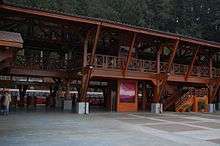Alishan Forest Railway
| Alishan Forest Railway | |
|---|---|
 Class B 28t Shay locomotive No.31 | |
| Overview | |
| Locale | Chiayi County, Taiwan |
| Coordinates | 23°30′36″N 120°48′15″E / 23.510092°N 120.804239°ECoordinates: 23°30′36″N 120°48′15″E / 23.510092°N 120.804239°E |
| Termini |
Chiayi Station Alishan Station |
| Connecting lines | Chiayi Station: TRA Western Line |
| Daily ridership | 5500[1] |
| Operation | |
| Opened | 1912 |
| Operator(s) | Taiwan Railways Administration |
| Technical | |
| Line length | 86 km (53 mi) |
| Track gauge | 2 ft 6 in (762 mm) |
| Highest elevation | 2,216 m (7,270 ft) |
| Alishan Forest Railway | |||||||||||||
| Traditional Chinese | 阿里山森林鐵路 | ||||||||||||
|---|---|---|---|---|---|---|---|---|---|---|---|---|---|
| |||||||||||||
The Alishan Forest Railway (Chinese: 阿里山森林鐵路; pinyin: Ālǐshān Sēnlín Tiělù) is an 86 km network of 2 ft 6 in (762 mm) narrow gauge railways running up to and throughout the popular mountain resort of Alishan in Chiayi County, Taiwan. The railway, originally constructed for logging, is itself a tourist attraction with unique Z-shaped switchbacks, 50 tunnels, and over 77 wooden bridges.[2]
History
Empire of Japan
The narrow gauge lines were originally constructed by the Japanese Colonial Government in 1912 to facilitate the logging of cypress and Taiwania wood, however today the line caters mostly to tourists. Passenger carriages were first added to the trains in 1918. The first motive power was a Shay locomotive purchased second hand from the Kiso Forest Railway in Japan. Eventually the railway acquired 20 Shay locomotives.
Eventually, diesel railcars supplemented the steam engines on the passenger services. In the 1980s, 10 Hitachi-built diesel-hydraulic locomotives were delivered and replaced the railcars and remaining steam engines.
Republic of China
The completion of the Alishan Highway in 1982 led to the loss of many rail passengers to faster and cheaper buses and the rail became primarily a tourist attraction.[2]
Accidents on the line have resulted in a number of fatalities over the years. On 24 April 1981, a collapsed tunnel resulted in nine deaths and 13 injuries. On 1 March 2003, 17 people were killed and 156 injured when a train derailed near Alishan Railway Station.[3] On 27 April 2011, five tourists, including three from mainland China, were killed and 113 people injured in a derailment.[4]
The railway line was severely damaged by rains associated with 2009's Typhoon Morakot and services are only running between Chiayi and Fenqihu since the typhoon occurred. In August 2015, the Chiayi-Fenchihu railway sections were damaged due to Typhoon Soudelor but was then opened again on 12 August 2015.[5] On 15 September 2015, the whole rail line underwent its first test run since the damaged made by the typhoon in 2009 and it is expected to be fully reopened to the public on 25 December 2015.[6]

Operation
Unlike the national rail system administered by the Taiwan Railway Administration (TRA), the Alishan Forest Railway is managed by the Council of Agriculture's (COA) Forestry Bureau. It was privatized through a build-operate-transfer (BOT) in June 2008[7] and maintained by the Hungtu Alishan International Development Corporation.[8]
However, the Forestry Bureau terminated the contract with Hungtu after damage to the railway caused by Typhoon Morakot in 2009 was not repaired to satisfaction.[8] As of January 2011, the Forestry Bureau and Hungtu were still engaged in lawsuits over the issue to determine who has the right to manage the railway.[8] In May 2011, the COA announce that it intended to transfer control of the railway to the TRA before the end of the year.[8]
The system is currently operated using diesel locomotives, although there are occasional special public runs using the old steam powered Shay locomotives.[9]
Taiwan's government has listed the forest railway as a potential World Heritage Site. However, Taiwan's exclusion from the United Nations means it is unlikely to be formally recognized as a WHS in the near future.
Lines
-
The front of the train on the Zhushan Line
-

The back of the train on the Zhushan Line
-

Zhushan Station

The main line runs from the city of Chiayi (elevation 30 m), to the final station of Alishan (elevation 2,216 m). The vegetation along the way changes from tropical to temperate and finally alpine. The line features many switchbacks on the way up the mountain.[10]
- Main Line or Alishan Line (阿里山線)
- Chiayi (嘉義) - Alishan (阿里山)
- Includes several steep gradients (max. 6.26%), a spiral and four switchbacks; longest line with most dramatic climate change.
- Reopened between Chiayi and Fenchihu (奮起湖) (approximately the halfway point) following typhoon damage repairs as of January 2014.[11]
- Alishan (阿里山) - Shenmu (神木站)
- Runs frequently all day, a short (5 minute) ride downhill to Shenmu station, a location used as one of the switchbacks for main line services
- Zhushan Line (祝山線)
- Alishan (阿里山) - Zhushan (祝山)
- Early morning trains, popular for viewing the sunrise over Jade Mountain
- Alishan (阿里山) - Chaoping (沼平車站)
- Runs frequently all day, a short (5 minute) ride uphill to Chaoping station
- Mianyue Line (眠月線)
- Alishan (阿里山) - The Stone Monkey (石猴)
- Closed indefinitely due to earthquake damage
- Shuishan Line (水山線)
List of stations

|
|
See also
References
- ↑ Shelley Shan (4 April 2016). "Alishan Forest Railway ticket prices to go up". The Taipei Times. Retrieved 3 May 2016.
- 1 2 Deborah Kuo. "Uncertain Future for Alishan Railway". Taipei Times. 28 September 2009. Retrieved 1 May 2011.
- ↑ "Taiwan's Alpine Rail".
- ↑ Shelly Shan. "Tourists Killed in Train Derailment". Taipei Times. 28 April 2011. Retrieved 1 May 2011.
- ↑ http://www.chinapost.com.tw/taiwan/local/chiayi/2015/08/11/442964/Alishan-Railway.htm
- ↑ http://www.chinapost.com.tw/taiwan/national/national-news/2015/09/18/446175/Alishan-Forest.htm
- ↑ "阿里山森林鐵路移交民營 航向新紀元".
- 1 2 3 4 Shelly Shan. "TRA to Take Control of Alishan Forest Railway". Taipei Times. 1 May 2011. Retrieved 1 May 2011.
- ↑ 阿里山SL-31號蒸汽機車運行記錄
- ↑ http://www.railway.gov.tw/tw/Alishan/page.html
- ↑ "Alishan tain goes to Fenqi Lake again".
External links
| Wikimedia Commons has media related to Alishan Forest Railway. |
- Alishan Forest Railway (Chinese)
- Alishan Forest Railway (Hungtu Alishan)(Chinese) (Japanese)

